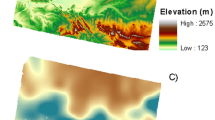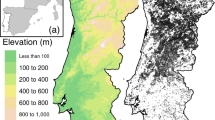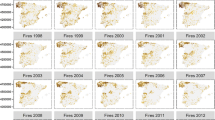Abstract
Recently, there has been increased interest in the behavior of wildfires. Behavior includes explaining: incidence of wildfires; recurrence times for wildfires; sizes, scars, and directions of wildfires; and recovery of burned regions after a wildfire. We study this last problem. In particular, we use the annual normalized difference vegetation index (NDVI) to provide a picture of vegetative levels. Employed post-wildfire, it provides a picture of vegetative recovery. The contribution here is to model post-fire vegetation recovery from a different perspective. What exists in the literature specifies a parametric monotone form for the recovery function and then fits it to the available data. However, recovery need not be monotone; NDVI levels may increase or decrease annually according to climate variables. Furthermore, when there is recovery, it need not follow a simple parametric form. Instead, we view recovery in a relative way. We model what NDVI would look like over the fire scar in the absence of a wildfire. Then, we can examine NDVI recovery locally, employing the observed NDVI recovery at a location relative to the predictive distribution of NDVI at that location. We work with wildfire data from the Communidad Autonomía of Aragón in Spain. We develop our approach in two stages. First, we validate the predictability of NDVI in the absence of wildfire. Then, we study annual recovery and evolution of recovery for an illustrative wildfire region. We work within a hierarchical Bayes framework, adopting suitable dynamic spatial models, attaching full uncertainty to our inference on recovery.










Similar content being viewed by others
Notes
NDVI values are aggregated from 30m to 60m by averaging.
References
Banerjee S, Carlin B, Gelfand A (2014) Hierarchical modeling and analysis for spatial data, 2nd edn. Chapman and Hall/CRC, Boca Raton
Besag J (1974) Spatial interaction and the statistical analysis of lattice systems. J R Stat Soc Ser B 36:192–236
De Santis A, Chuvieco E (2007) Burn severity estimation from remotely sensed data: performance of simulation versus empirical models. Remote Sens Environ 108:422–435
Díaz-Delgado R, Pons X (2001) Spatial patterns of forest fires in Catalonia (NE of Spain) along the period 1975–1995: analysis of vegetation recovery after fire. For Ecol Manag 147:67–74
Díaz-Delgado R, Lloret F, Pons X (2003) Influence of fire severity on plant regeneration by means of remote sensing imagery. Int J Remote Sens 24:1751–1763
Epting J, Verbyla D, Sorbel B (2005) Evaluation of remotely sensed indices for assessing burn severity in interior Alaska using Landsat TM and ETM+. Remote Sens Environ 96:328–339
Fisher R (1915) Frequency distribution of the values of the correlation coefficient in samples of an indefinitely large population. Biometrika 10:507–521
Gelfand A, Banerjee S, Gamerman D (2005) Spatial process modelling for univariate and multivariate dynamic spatial data. Environmetrics 16:465–479
Glenn E, Huete S, Nagler P, Nelson S (2008) Relationship between remotely-sensed vegetation indices, canopy attributes and plant physiological processes: what vegetation indices can and cannot tell us about the landscape. Sensors 8:2136–2160
Gneiting T, Raftery A (2007) Strictly proper scoring rules, prediction, and estimation. J Am Stat Assoc 102:359–378
Gouveia C, DaCamara C, Trigo R (2010) Post-fire vegetation recovery in Portugal based on spot/vegetation data. Nat Hazards Earth Syst Sci 10:673–684
Huang S, Jin S, Dahal D, Chen X, Young C, Liu H, Liu S (2013) Reconstructing satellite images to quantify spatially explicit land surface change caused by fires and succession: a demonstration in the Yukon River Basin of interior Alaska. ISPRS J Photogramm Remote Sens 79:94–105
Jakubauskas M, Lulla K, Mausel P (1990) Assessment of vegetation change in a fire-altered forest landscape. Photogramm Eng Remote Sens 56:371–377
Key C, Benson N (2006) Landscape assessment. In: Lutes D, Keane R, Caratti J, Key C, Benson N, Sutherland S, Gangi L (eds) Firemon, fire effects monitoring and inventory system. USDA Forest Service, Ogden, pp 1–55
McKenzie D, Gedalof Z, Peterson D, Mote P (2004) Climatic change, wildfire, and conservation. Conserv Biol 18:890–902
Miller J, Thode A (2007) Quantifying burn severity in a heterogeneous landscape with a relative version of the delta Normalized Burn Ratio (dNBR). Remote Sens Environ 109:66–80
Moreno M, Conedera M, Chuvieco E, Pezzatti G (2014) Fire regime changes and major driving forces in Spain from 1968 to 2010. Environ Sci Policy 37:11–22
Naveh Z (1975) The evolutionary significance of fire in the Mediterranean region. Vegetatio 29:199–208
Parks S, Dillon G, Miller C (2014) A new metric for quantifying burn severity: the relativized burn ratio. Remote Sens 6:1827–1844
Pausas J (2001) Resprouting vs seeding a Mediterranean perspective. Oikos 94:193–194
Pausas J (2003) The effect of landscape pattern on Mediterranean vegetation dynamics—a modelling approach using functional types. J Veg Sci 14:365–374
Pausas J, Keeley J (2009) A burning story: the role of fire in the history of life. Bioscience 59:593–601
Pérez-Cabello F, Echeverría M, Ibarra P, Riva J (2009) Effects of fire on vegetation, soil and hydrogeomorphological behavior in Mediterranean ecosystems. In: Chuvieco E (ed) Earth observation of wildland fires in Mediterranean ecosystems. Springer, Berlin, pp 111–128
Petropoulos G, Griffiths M, Kalivas D (2014) Quantifying spatial and temporal vegetation recovery dynamics following a wildfire event in a Mediterranean landscape using EO data and GIS. Appl Geogr 50:120–131
Röder A, Duguy B, Alloza J, Vallejo R, Hill J (2008) Using long time series of Landsat data to monitor fire events and post-fire dynamics and identify driving factors. Remote Sens Environ 112:259–273
Rouse J, Hass R, Schell J, Deering D (1974) Monitoring vegetation systems in the great plains with ERTS. NASA Spec Publ 351:309
Stroud J, Müller P, Sansó B (2001) Dynamic models for spatio-temporal data. J R Stat Soc Ser B 63:673–689
Trabaud L (1994) Post-fire plant community dynamics in the Mediterranean basin. In: Moreno J, Oechel W (eds) The role of fire in Mediterranean-type ecosystems. Springer, New York
Veraverbeke S, Gitas I, Katagis T, Polychronaki A, Somers B, Goossens R (2012) Assessing post-fire vegetation recovery using red-near infrared vegetation indices: accounting for background and vegetation variability. ISPRS J Photogramm Remote Sens 68:28–39
Vicente-Serrano S, Beguera S, López-Moreno J (2010) A Multi-scalar drought index sensitive to global warming: the standardized precipitation evapotranspiration index SPEI. J Clim 23:1696–1718
Vicente-Serrano S, Pérez-Caballo F, Lasanta T (2011) Pinus halepensis regeneration after a wildfire in a semi-arid environment: assessment using multi-temporal Landsat images. Int J Wildl Fire 20:195–208
Viedma O, Meliá J, Segarra D, García-Haro J (1997) Modeling rates of ecosystem recovery after fires by using Landsat TM data. Remote Sens Environ 61:383–398
Vila G, Barbosa P (2010) Post-fire vegetation regrowth detection in the Deiva Marina region (Liguria-Italy) using Landsat TM and ETM+ data. Ecol Model 221:75–84
van Wagtendonk J, Root R, Key C (2004) Comparison of AVIRIS and Landsat ETM+ detection capabilities for burn severity. Remote Sens Environ 92:397–408
West M, Harrison J (1997) Bayesian forecasting and dynamic models, 2nd edn. Springer, New York
Wilson A, Latimer A, Silander J Jr, Gelfand A, de Klerk H (2010) A hierarchical bayesian model of wildfire in a Mediterranean biodiversity hotspot: Implications of weather variability and global circulation. Ecol Model 221:106–112
Wilson A, Latimer A, Silander J Jr (2015) Climatic controls on ecosystem resilience: post-fire regeneration in the Cape Floristic Region of South Africa. PNAS 112:9058–9063
Yang Y, Xu J, Hong Y, Lv G (2012) The dynamic of vegetation coverage and its response to climate factors in Inner Mongolia, China. Stoch Environ Res Risk Assess 26:357–373
Acknowledgments
The research of the first author was partially supported by the Statistical and Applied Mathematical Sciences Institute (SAMSI) within the Program on Mathematical and Statistical Ecology 2014–2015. The research of the second authors was facilitated by a travel award from Campus IBERUS. The work of the third author was supported in part by Grupo Consolidado Modelos Stocasticos, E-22 DGA. The work of the fourth and fifth authors was done under the Instituto Universitario de Investigacion en Ciencias Ambientales (IUCA). The authors thank Adam Wilson for providing a preprint of his forthcoming PNAS paper. We thank the anonymous reviewers for their comments which have improved the paper.
Author information
Authors and Affiliations
Corresponding author
Electronic supplementary material
Below is the link to the electronic supplementary material.
Rights and permissions
About this article
Cite this article
Paci, L., Gelfand, A.E., Beamonte, M.A. et al. Space-time modeling for post-fire vegetation recovery. Stoch Environ Res Risk Assess 31, 171–183 (2017). https://doi.org/10.1007/s00477-015-1182-6
Published:
Issue Date:
DOI: https://doi.org/10.1007/s00477-015-1182-6




